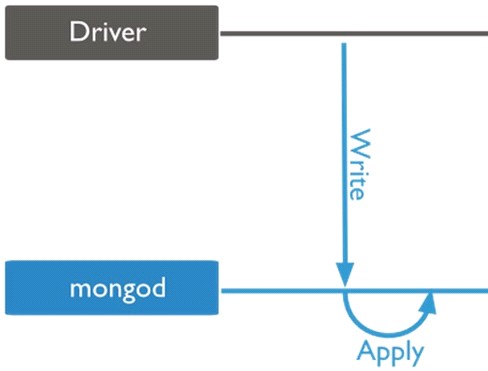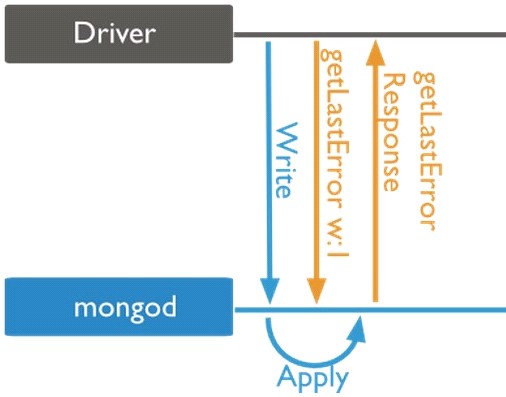Write Operations
A write operation is any operation that creates or modifies data in the MongoDB instance. In MongoDB, write operations target a single collection. All write operations in MongoDB are atomic on the level of a single document. There are three classes of write operations in MongoDB: insert, update, and remove. Insert operations add new data to a collection. Update operations modify existing data, and remove operations delete data from a collection. No insert, update, or remove can affect more than one document atomically.
For the update and remove operations, you can specify criteria, or conditions, that identify the documents to update or remove. These operations use the same query syntax to specify the criteria as read operations. After issuing these modification operations, MongoDB allows applications to determine the level of acknowledgment returned from the database.
Create – Create operations add new documents to a collection. In MongoDB, the db.collection.insert() method performs create operations. The following diagram highlights the components of a MongoDB insert operation.

The following diagram shows the same query in SQL:

As an example, the following operation inserts a new documents into the user’s collection. The new document has four fields name, age, and status, and an _id field. MongoDB always adds the _id field to the new document if that field does not exist.
db.users.insert(
{
name: “sue”,
age: 26,
status: “A”
}
)
This operation inserts a new document into the user’s collection. The new document has four fields: name, age, status, and an _id field. MongoDB always adds the _id field to a new document if the field does not exist. Some updates also create records. If an update operation specifies the upsert flag and there are no documents that match the query portion of the update operation, then MongoDB will convert the update into an insert.
With an upsert, applications can decide between performing an update or an insert operation using just a single call. Both the update() method and the save() method can perform an upsert.
Insert Behavior – If you add a new document without the _id field, the client library or the mongod instance adds an _id field and populates the field with a unique ObjectId. If you specify the _id field, the value must be unique within the collection. For operations with write concern, if you try to create a document with a duplicate _id value, mongod returns a duplicate key exception.
Update – Update operations modify existing documents in a collection. In MongoDB, db.collection.update() and the db.collection.save() methods perform update operations. The db.collection.update() method can accept query criteria to determine which documents to update as well as an option to update multiple rows. The method can also accept options that affect its behavior such as the multi option to update multiple documents. The following diagram highlights the components of a MongoDB update operation:

The following diagram shows the same query in SQL:

As an example,
db.users.update(
{ age: { $gt: 18 } },
{ $set: { status: “A” } },
{ multi: true }
)
This update operation on the user’s collection sets the status field to A for the documents that match the criteria of age greater than 18.
Update Behavior – By default, the db.collection.update() method updates a single document. However, with the multi option, update() can update all documents in a collection that match a query. The db.collection.update() method either updates specific fields in the existing document or replaces the document.
When performing update operations that increase the document size beyond the allocated space for that document, the update operation relocates the document on disk and may reorder the document fields depending on the type of update. The db.collection.save() method replaces a document and can only update a single document.
Delete – Delete operations remove documents from a collection. In MongoDB, db.collection.remove() method performs delete operations. The db.collection.remove() method can accept query criteria to determine which documents to remove.
The following diagram highlights the components of a MongoDB remove operation:

The following diagram shows the same query in SQL:

As an example,
db.users.remove(
{ status: “D” }
)
This delete operation on the user’s collection removes all documents that match the criteria of status equal to D.
Remove Behavior – By default, db.collection.remove() method removes all documents that match its query. However, the method can accept a flag to limit the delete operation to a single document.
Isolation of Write Operations – The modification of a single document is always atomic, even if the write operation modifies multiple sub-documents within that document. For write operations that modify multiple documents, the operation as a whole is not atomic, and other operations may interleave. No other operations are atomic. You can, however, attempt to isolate a write operation that affects multiple documents using the isolation operator. To isolate a sequence of write operations from other read and write operations.
Write Concern – Write concern describes the guarantee that MongoDB provides when reporting on the success of a write operation. The strength of the write concerns determine the level of guarantee. When inserts, updates and deletes have a weak write concern, write operations return quickly. In some failure cases, write operations issued with weak write concerns may not persist. With stronger write concerns, clients wait after sending a write operation for MongoDB to confirm the write operations.
MongoDB provides different levels of write concern to better address the specific needs of applications. Clients may adjust write concern to ensure that the most important operations persist successfully to an entire MongoDB deployment. For other less critical operations, clients can adjust the write concern to ensure faster performance rather than ensure persistence to the entire deployment.
The driver write concern change created a new connection class in all of the MongoDB drivers. The new class, called MongoClient, changed the default write concern.
Write Concern Levels – Clients issue write operations with some level of write concern. MongoDB has the following levels of conceptual write concern, listed from weakest to strongest:

Unacknowledged – With an unacknowledged write concern, MongoDB does not acknowledge the receipt of write operation. Unacknowledged is similar to errors ignored; however, drivers attempt to receive and handle network errors when possible. The driver’s ability to detect network errors depends on the system’s networking configuration. To set unacknowledged write concern, specify w values of 0 to your driver. Before the releases outlined in Default Write Concern Change, this was the default write concern.
Write operation to a “mongod“ instance with write concern of “unacknowledged“. The client does not wait for any acknowledgment. Write operation to a mongod instance with write concern of unacknowledged. The client does not wait for any acknowledgment.
Acknowledged – With a receipt acknowledged write concern, the mongod confirms the receipt of the write operation. Acknowledged write concern allows clients to catch network, duplicate key, and other errors. To set acknowledged write concern, specify w values of 1 to your driver. MongoDB uses acknowledged write concern by default, after the releases outlined in Default
Write Concern Change – Write operation to a “mongod“ instance with write concern of “acknowledged“. The client waits for acknowledgment of success or exception. Write operation to a mongod instance with write concern of acknowledged. The client waits for acknowledgment of success or exception. Internally, the default write concern calls getLastError with no arguments. For replica sets, you can define the default write concern settings in the getLastErrorDefaults. When getLastErrorDefaults does not define a default write concern setting, getLastError defaults to basic receipt acknowledgment.
Journaled – With a journaled write concern, the mongod acknowledges the write operation only after committing the data to the journal. This write concern ensures that MongoDB can recover the data following a shutdown or power interruption. To set a journaled write concern, specify w values of 1 and set the journal or j option to true for your driver. You must have journaling enabled to use this write concern.
With a journaled write concern, write operations must wait for the next journal commit. To reduce latency for these operations, you can increase the frequency that MongoDB commits operations to the journal.

Write operation to a “mongod“ instance with write concern of “journaled“. The “mongod“ sends acknowledgment after it commits the write operation to the journal.
Write operation to a mongod instance with write concern of journaled. The mongod sends acknowledgment after it commits the write operation to the journal.
Requiring journaled write concern in a replica set only requires a journal commit of the write operation to the primary of the set regardless of the level of replica acknowledged write concern.
Apply for MongoDB Certification Now!!
https://www.vskills.in/certification/databases/mongodb-server-administrator

